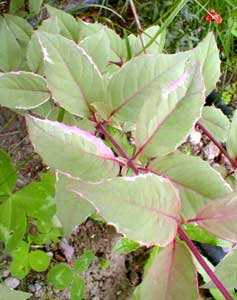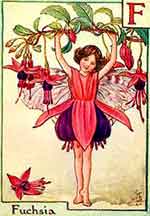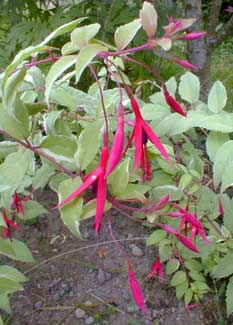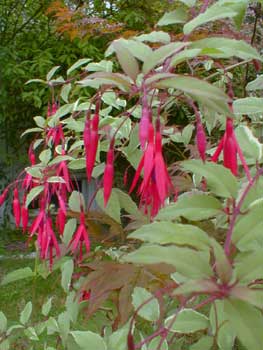
Variegated
Hardy Fuchsia
 "Fuchsia is a dancer
"Fuchsia is a dancer
Dancing on her toes,
Clad in red and purple,
Sometimes in a greenhouse
By a cottage wall;
In frilly white & rose,
Dressed in her best for the
Fairies' evening ball!"
-Cicely Mary Barker's
Song of the Fuchsia Fairy,
1936
Song of the Fuchsia Fairy,
1936
My great-grandmother Elvie called her fuchsias "hanging ladies" by which they were known when she was a little girl in Illinois in the late 1800s. The name always induced me to view them as little red-dressed girls dangling from willowy gallows. I was middleaged before it dawned on me that other people did not grow up hearing them called by such a macabre name.
I suppose it isn't impossible Gran only meant hanging in the manner of Cicely Mary Barker's acrobatic fuchsia-fairy ready to do pull-ups, but I doubt it. Great-gran married a Yakama Indian & Mississippi riverboat gambler & she returned with him to the Northwest after being disowned by her family on account of Grampa's race. Her people were English, & I suspect Hanging Ladies was a forgotten English knickname that followed her family to America, perhaps related to some forgotten legend of London's East End docks, where prostitutes & cutthroats hobnobbed with authors, judges, city officials, & even nurserymen.
 In 1780, a sailor named John Westcombe, fresh off a ship docked at Wapping, went into the notorious Devil's Tavern & handed over fuchsia cuttings to a nurseryman named Lea, in trade for a noggin of rum. These were the first fuchsias seen in England, the flowers of which resembled the very "hanging" ladies as were Devil's Tavern harlots clad in red, who hung out in the East End taverns or draped themselves in langorous poses in nearby bordellos, much as fuchsias drape themselves from garden ledges or out of baskets.
In 1780, a sailor named John Westcombe, fresh off a ship docked at Wapping, went into the notorious Devil's Tavern & handed over fuchsia cuttings to a nurseryman named Lea, in trade for a noggin of rum. These were the first fuchsias seen in England, the flowers of which resembled the very "hanging" ladies as were Devil's Tavern harlots clad in red, who hung out in the East End taverns or draped themselves in langorous poses in nearby bordellos, much as fuchsias drape themselves from garden ledges or out of baskets.Fuchsia magellanica gracilis 'Variegata' is native to Chile & Argentina, & garden-hardy in zones 7-10. It grows two feet tall or a bit higher, with three to four foot fountaining reach. Now & then ours has an upright branch that is four to five feet high, but usually it arches outward & down. It is often used in hanging baskets. It also likes a hill top or ledge to fountain down or over.
Flowers have red sepals & purple corollas beginning about mid-June & lasting until Autumn frosts, for a very long blooming season. Ours is as much in bloom in October as it is in July, with a few lingering blooms into winter.
But it is if anything even more beautiful before it blooms. Young leaves from early spring up through June are a brilliantly variegated creamy white, pink, & green, as shown in the first photo above.
 By the time it blooms, the leaves have begun their process of fading to a pallid green with slight white variegation, so foliage is still unique the rest of the year, just not as startling as in spring.
By the time it blooms, the leaves have begun their process of fading to a pallid green with slight white variegation, so foliage is still unique the rest of the year, just not as startling as in spring.This subshrub is nearly evergreen but often so spotty or scruffy by winter's end it is a good idea to cut it back dramatically & let it start over. If hard pruned late winter or early spring, it will permit the fresh variegated leaves to dominate through spring.
Like many long-flowering plants it can be a heavy feeder & benefits by a monthly liquid fertilizer during the blooming months, though if neglected it will merely be less heavily flowered, which is still quite a lot of flowers, & the overall appearance scarsely less pleasing.
It likes full morning sun followed by a long shady day, but is adaptable as to light, & along the coastal Northwest can tolerate longer periods of full sun either morning or afternoon, but not both or its sensitively pale leaves will be sunburnt.
In too deep a shade, the colorfulness of the spring leaves may be less intense but will keep whatever color they do achieve longer into summer. Though sometimes described as a suitable shade plant, in reality it will not bloom at all well without at minimum good morning sun. Soil should be loamy & moist, but not boggy. It can be propagated from cuttings.
Ours however has a shady morning under an 'Oshio Beni' Japanese maple, then a little direct sunlight & plenty of dappled sunlight throughout the afternoon. If grown farther north, it likes a sunnier location overall, winter mulch, & will behave more as a die-back perennial.
Variegated Hardy Fuchsia is a recipient of the Award of Garden Merit from the Royal Botanical Society, an honor bestowed on plants that have proven their gardenable excellence, beauty, & ease of growth over time.